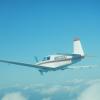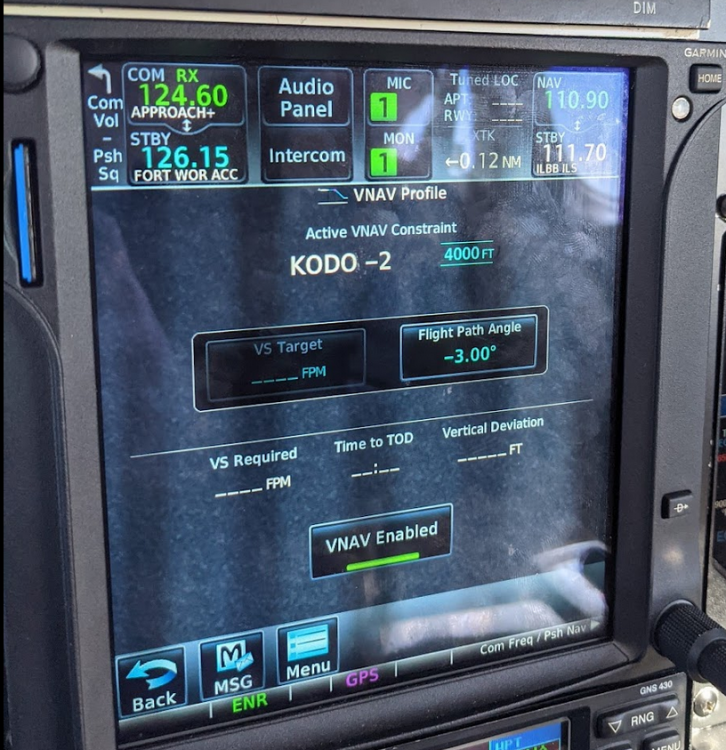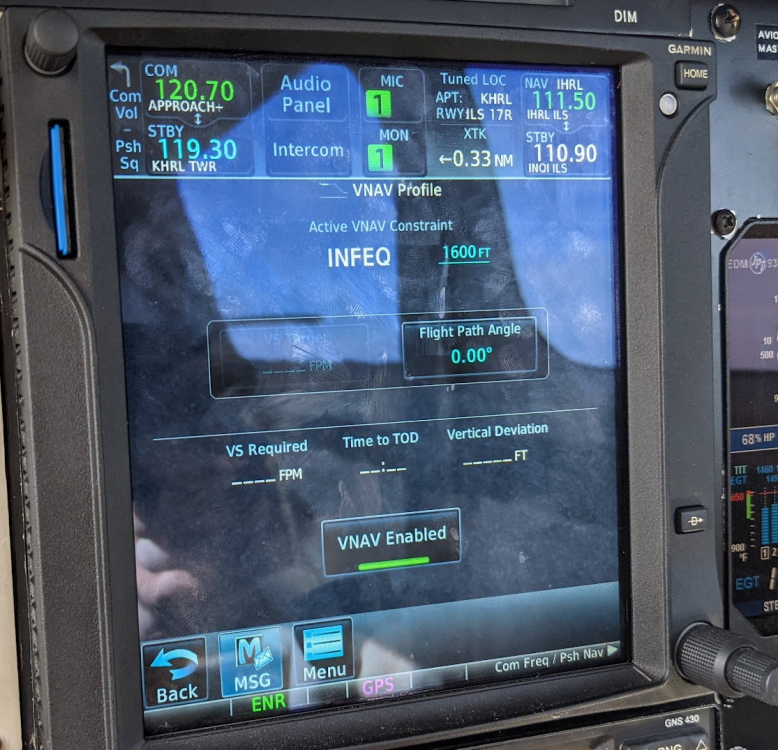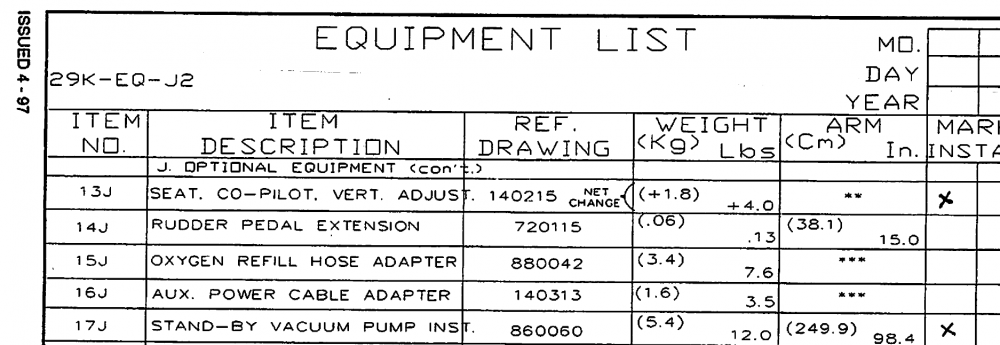-
Posts
543 -
Joined
-
Last visited
Content Type
Profiles
Forums
Blogs
Gallery
Downloads
Media Demo
Events
Everything posted by smwash02
-

If I have two AHRS can I get rid of my vacuum system?
smwash02 replied to RobertGary1's topic in General Mooney Talk
Either I have a confusion in my understanding of the 275 product models or there's a disconnect here. Garmin says if you have two ADAHRS units it'll auto-switch the other, like what the pilot said he expected, but TSB CA says this is not correct. "Primary HSI" seems to be the keyword. I suppose there's a model that's an HSI without the ADAHRS? Further it says a 275 MFI was installed in the incident plane. The Garmin 275 Product Page lists a 'MFD', which is what is maybe what is meant here? I can see the MFD not having ADAHRS, it wouldn't need it. From: Garmin's GI275 blog You can count on the reliability of the GI 275, but primary instruments often require backups. With the installation of a GI 275 attitude indicator and GI 275 HSI, you get the benefit of auto-reversionary mode2. This mode kicks in and displays attitude and heading data on the remaining HSI or MFD if an outage should occur. If that doesn’t provide enough peace of mind, then consider the GI 275 attitude indicator’s backup battery — it provides up to 60 minutes of power to get you home. 2Both GI 275 units must be ADAHRS versions to support reversionary capability From the tsb.gc.ca site: When a unit is configured as a primary HSI and a fault occurs with an interconnected unit, it will not automatically switch to reversionary operation mode. In addition, the pilot cannot manually select the ADI display page because it is not one of the pages available when the unit is configured as a primary HSI. Pages available for a primary HSI configuration are HSI and HSI Map; pages available for standby ADI and standby HSI include an ADI page. In July 2020, the occurrence aircraft’s directional gyro was removed and a Garmin GI 275 MFI was installed in accordance with U.S. Federal Aviation Administration Supplemental Type Certificate (STC) SA02658SE.Footnote 14 This MFI was configured as a primary HSI. In October 2020, the aircraft’s attitude indicator was removed and a second Garmin GI 275 MFI was installed in accordance with the same STC, but was configured as a primary ADI. Because both of these instruments were configured as primary units, a reversionary switch was not installed, nor was it required to be. The aircraft’s owner and the occurrence pilot both thought that if a fault was detected in the ADI, the HSI would either automatically enter the reversionary operation mode and display the ADI page, or the pilot would be able to select the ADI page manually. Therefore, their understanding of both the system’s automation and the units’ reversionary capabilities was incorrect. -
A bummer you didn't post yesterday. I flew into HRL and TXW yesterday in my K, would've been an easy hop over to MFE. I go to the Valley somewhat often, but there are others like @RLCarter who live in the area.
-
I did, approach was loaded and active. Attaching another one I did recently -- photo of both the FPL and VNAV screen. Was at FL120 and 42 miles out.
-
Thanks for the reply. I have set those and it works in the trainer but not on my plane's 750. In the photo above you can see I have an active constraint set but no TOD is shown and my target VS is greyed out -- which it always is on my 750.
-
I have a GTN750 and I recently upgraded the firmware to the latest and one of my favorite features has been removed / rewritten. Under utilities there was a VNAV/VCALC button and I had this defaulted for 1000AGL 2NM from destination, but you could also set it to be at a certain altitude for crossing fixes and it'd give you VS required based on current location or time to start an X FPM descent, etc. I can do it in my head of course, but this is easier. It seems with the new version none of this is configurable anymore, but rather must be a part of a flight plan. Inconvenient, but alright. The problem is even when I added the altitudes and activate it, it still doesn't ever show the VS required or TOD. I think the issue is my VS target is greyed out. I tinkered with it for 20-30 minutes in flight but couldn't get it to work. I loaded up the Garmin trainer and was able to get the TOD timer to work and am actually able to adjust the VS target, but it never shows the VS required. My unit is on 6.71 and the trainer is 6.70.29, so there is some variance. Photo of my panel attached here. Anyone have any guidance on how this should work or does this new feature only work with a Garmin A/P attached?
-
Twinkies are Twin Comanches Interesting data point. I wonder how the flight path/weather decisions plays into this. I am more conservative in the terrain / time I'll fly in my Mooney than I would be in a twin. If I had a twin with real weather radar, this would change my decision making and path choices. Adding to my comments above, I wonder if the situations a twin pilot finds themselves in have fewer 'outs' than singles from being able to and entering situations that would be beyond the risk tolerance for most in a single. I would be curious to see that data overlaid with if it was weather/terrain related.
-
Like what Ford did with the Mustang?
-
I don't use low boost when switching tanks and have never had a stumble. I have turned low boost on to see its effects during a climb and while I see the GPH momentarily rise, it's never produced a stumble. I suspect because of your lower power setting it got overrich for a moment. Unless I have to, I only switch tanks with altitude and hospitable terrain in case the fuel selector fails or it will require a restart because something was wrong with the other tank and I had to switch back.
-
@philiplaneThanks for the info. I aim for keeping them under 400 in the climb. I am usually under 390 unless I have something to get over or a SID. My baffles are in pretty good shape, which may be helping me there. I don't have my JPI data on me, but I want to say I'm in the upper 1200s, low 1300s for EGTs in the climb.
-
I have a TSIO-360-SB2SB, which is what the Encore uses. The service manual calls for 21.5-23.2 for the MB and 25.5-26.5GPH for the SB. (Just above 71-00-60) Your point is valid-- I've done some experimenting with leaning the engine to see if the excessive fuel flow is robbing the horsepower and it helps some at the expense of cooling.
-
I climb at 39" / 2600 RPM and have my FF adjusted to 25.5-26GPH. At gross it will usually give me 700-800FPM at 100KIAS and things will tend to stay under 380-390 even on a hot day. I tend to have to tinker as I climb to keep the airspeed up enough to keep things below 400. Would love to hear others with Encore's climb rates at or near gross. I've never been able to hold 1,000FPM the whole way without bleeding under 85KIAS and things getting hot.
-
The article @philiplanesuggests a RR500TP. The Wiki for the engine per the RR data says just shy of 300lbs/hr on take off and 240lbs/hr in normal cruise. JetA is roughly 6.7lbs/gal, so 45GPH on take off and 36GPH in cruise. Just spitballing, if you could get 2000FPM in the climb to FL180, that would be 9 minutes from sea level -- 7 gallons. 45 minute reserve, 27 gallons. I've got 101 gallons with my LR tanks, so I'd be left with 67 for cruise or about 1 hour and 50 minutes. Need to factor in the 20-30 minutes on the ground as well. I'd love the climb performance, but the loss of range capability wouldn't be worth it for me.
-
Very cool project and hope you keep us appraised!
-
Thanks for the info. If it makes you feel any better about yours, I don't have leashes on mine either and have the same worry. I briefly lost one on my 150 years ago, which turned up on a taxiway, and have been hyper diligent since.
-
I also have the Monroy tanks in my K, but all 4 of my caps look the same, probably are all the Shaw #531-001 in your parts list. I know for sure they're not Newton ones like your photo. Regarding the part numbers -- 05-21999 is the A/C spruce catalog number for the manufacturer (Newton) part number A3L. It looks like Newton expanded their part numbers at some point. On the Aero 300 page, A3L correlates to CA-AA-005, which is their locking silver cap. Unless you have a locking one, I suspect you'd need the A3S -- if it's the right one. Perhaps you could email them some photos? A bummer the part number isn't stamped on it. The #531-001 is a 60mm diameter and the A3S is 57.7 center / 62.5 outer per the spec sheet. Might be worth the $100 gamble. I wonder if they're interchangeable with the Shaw caps.
-
Did you have a decent amount of multi time prior? A deal for a Piper Geronimo crossed my path about 6 months ago and I was entertaining picking it up to get my multi. I (~1500TT, ~1000 retract, IFR) asked for it to be insured for $30k and they came back saying they can't cover the hull and it would be $4k for liability only. I pay half that for my Encore with a hull of nearly 7 time more. I asked if I could get a clause requiring X hours with an instructor before flying solo or with passengers, but they wouldn't do it. They said to get my multi and 20 hours and come back and try again. I passed.
-

Trying to locate Robert Cowell owner of N411JL
smwash02 replied to Harrio's topic in General Mooney Talk
Ownership history suggest Smoky Mountain Aeroplanes might've brokered the sale. Might be a possible avenue to contact the owner. -
Cheap anything, from my School of Hard Knox experience, are more expensive when it's said and done. Best of luck in your search!
-
@201eris correct it is beyond TBO, but if a within calendar year TBO were a strict requirement you'll probably cut 70% of the planes from the choices. 250 hours over 26 years would be my primary concern. Hoses and most gaskets are economically solvable problems. Pitted cranks less so.
-

W&B - the arm for the backup electric vacuum
smwash02 replied to aviatoreb's topic in Modern Mooney Discussion
This article suggests that when the 231 moved to a 28V system, the electric vacuum backup became standard equipment. -

W&B - the arm for the backup electric vacuum
smwash02 replied to aviatoreb's topic in Modern Mooney Discussion
Welcome. Hopefully someone else can chime in and confirm, but it's my understanding the 231 didn't offer the dual alternator or backup vacuum. It is a stock feature of the 252. -

W&B - the arm for the backup electric vacuum
smwash02 replied to aviatoreb's topic in Modern Mooney Discussion
-

Garmin dual attitude indicator failures with data
smwash02 replied to RobertGary1's topic in General Mooney Talk
This is great, but when there's a RAIM failure or GPS interference and we have to fly radar vectors / via VORs and there's an airspeed issue we're going to lose attitude and autopilot driving ability? I get it's a somewhat unicorn situation, but quite shortsighted. The yellow box warning idea @N201MKTurbo suggested is a much better solution, in my opinion. -

If I have two AHRS can I get rid of my vacuum system?
smwash02 replied to RobertGary1's topic in General Mooney Talk
@RobertGary1Thanks for taking us along as you work through this with Garmin. Your ice story and the flip cover likely have correlation in what the sensor was seeing as @takairsuggested. We'll have to see what the RCA was, but if it really is a glitch in the airspeed reading that breaks the AHRS system, it wouldn't be far fetched to expect the same code to be shared across all their products. Thus, all would break under the same scenario. You've 'inspired' me to grab a simple electric AI gyro that isn't Garmin (the rest of my stack is) to protect myself as I finalize my vacuum system removal. An AV-20 or AV-30 probably. -

If I have two AHRS can I get rid of my vacuum system?
smwash02 replied to RobertGary1's topic in General Mooney Talk
AHRS is Attitude and Heading Reference System. ADAHRS is Air Data, Attitude, and Heading Reference System that it would be a part of. If you lose airspeed, it should X out the airspeed, but not the attitude. There's another thread here about a guy who had a problem with his airspeed not working (I think it was the pitot cover was on?) and he had attitude information, which enough evidence for me to say "if the pitot/static stops working, attitude will continue on"... unless there is software issue that causes the attitude to fail if the airspeed sensor does. In your case, the chances of both having hardware failures at the same time is possible, but pretty unlikely. Edit: Here is the link where the video is that shows the twin 275s not having airspeed due to pitot/static cover and the devices remain functional for attitude.






